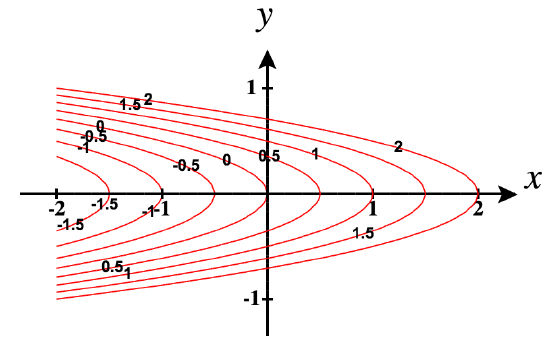5.10: Chapter 5 Review Exercises
- Last updated
- Sep 11, 2021
- Save as PDF
- Page ID
- 84041
( \newcommand{\kernel}{\mathrm{null}\,}\)
For the following exercises, determine whether the statement is true or false. Justify your answer with a proof or a counterexample.
1. The domain of f(x,y)=x3arcsin(y) is {(x,y)|x∈R and −π≤y≤π}.
2. If the function f(x,y) is continuous everywhere, then fxy(x,y)=fyx(x,y).
- Answer
- True, by Clairaut’s theorem
3. The linear approximation to the function of f(x,y)=5x2+xtany at the point (2,π) is given by L(x,y)=22+21(x−2)+(y−π).
4. (34,916) is a critical point of g(x,y)=4x3−2x2y+y2−2.
- Answer
- False
For the following exercises, sketch the function in one graph and, in a second, sketch several level curves.
5. f(x,y)=e−(x2+2y2)
6. f(x,y)=x+4y2
- Answer

For the following exercises, evaluate the following limits, if they exist. If they do not exist, prove it.
7. lim(x,y)→(1,1)4xyx−2y2
8. lim(x,y)→(0,0)4xyx−2y2
- Answer
- Does not exist.
For the following exercises, find the largest interval of continuity for the function.
9. f(x,y)=x3arcsiny
10. g(x,y)=ln(4−x2−y2)
- Answer
- Continuous at all points on the xy-plane, except where x2+y2>4.
For the following exercises, find all first partial derivatives.
11. f(x,y)=x2−y2
12. u(x,y)=x4−3xy+1, with x=2t and y=t3
- Answer
- ∂u∂x=4x3−3y,
∂u∂y=−3x,
dxdt=2 and dydt=3t2
dudt=∂u∂x⋅dxdt+∂u∂y⋅dydt=8x3−6y−9xt2=8(2t)3−6(t3)−9(2t)t2=64t3−6t3−18t3=40t3
For the following exercises, find all second partial derivatives.
13. g(t,x)=3t2−sin(x+t)
14. h(x,y,z)=x3e2yz
- Answer
- hxx(x,y,z)=6xe2yz,
hxy(x,y,z)=6x2e2yz,
hxz(x,y,z)=−3x2e2yz2,
hyx(x,y,z)=6x2e2yz,
hyy(x,y,z)=4x3e2yz,
hyz(x,y,z)=−2x3e2yz2,
hzx(x,y,z)=−3x2e2yz2,
hzy(x,y,z)=−2x3e2yz2,
hzz(x,y,z)=2x3e2yz3
For the following exercises, find the equation of the tangent plane to the specified surface at the given point.
15. z=x3−2y2+y−1 at point (1,1,−1)
16. z=ex+2y at point (0,1,3)
- Answer
- z=x−2y+5
17. Approximate f(x,y)=ex2+√y at (0.1,9.1). Write down your linear approximation function L(x,y). How accurate is the approximation to the exact answer, rounded to four digits?
18. Find the differential dz of h(x,y)=4x2+2xy−3y and approximate Δz at the point (1,−2). Let Δx=0.1 and Δy=0.01.
- Answer
- dz=4dx−dy,dz(0.1,0.01)=0.39,Δz=0.432
19. Find the directional derivative of f(x,y)=x2+6xy−y2 in the direction ⇀v=ˆi+4ˆj.
20. Find the maximal directional derivative magnitude and direction for the function f(x,y)=x3+2xy−cos(πy) at point (3,0).
- Answer
- 3√85⟨27,6⟩
For the following exercises, find the gradient.
21. c(x,t)=e(t−x)2+3cost
22. f(x,y)=√x+y2xy
- Answer
- ⇀∇f(x,y)=−√x+2y22x2yˆi+(1x+1√xy2)ˆj
For the following exercise, find and classify the critical points.
For the following exercises, use Lagrange multipliers to find the maximum and minimum values for the functions with the given constraints.
24. f(x,y)=x2y, subject to the constraint: x2+y2=4
- Answer
- maximum: 163√3, minimum: −163√3,
25. f(x,y)=x2−y2, subject to the constraint: x+6y=4
26. A machinist is constructing a right circular cone out of a block of aluminum. The machine gives an error of 5% in height and 2% in radius. Find the maximum error in the volume of the cone if the machinist creates a cone of height 6 cm and radius 2 cm.
- Answer
- 2.3228 cm3
27. A trash compactor is in the shape of a cuboid. Assume the trash compactor is filled with incompressible liquid. The length and width are decreasing at rates of 2 ft/sec and 3 ft/sec, respectively. Find the rate at which the liquid level is rising when the length is 14 ft, the width is 10 ft, and the height is 4 ft.


